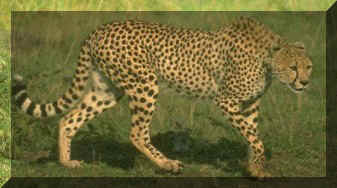

Cheeta
Status: Endangered.
Description: Tawny,
coarse coat with round black spots, "tear stripes" from the corner of the eyes
down the sides of the nose; slender, long-legged body with blunt, non-retractable claws.
Small head, high-set eyes and small ears.
Size: 44-53 inches
long with a tail length of 26-33 inches. Weight 86-143 pounds (Males slightly larger that
females).
Specializations: The
cheetah's flexible spine, oversized liver, enlarged heart, slender muscular body, and
claws make it the swiftest hunter in Africa and the fastest animal on land. Can reach
speeds of up to 60 miles per hour.
Habitat: Grassy
plains, dense bush and mountain train.
Range: Once found
throughout Africa and Asia, cheetahs are now only scattered through eastern Africa and
through a region of southwestern Africa. Home ranges can cover and area up to 800 square
kilometers (310 square miles).
Food Source:
Gazelles, wildebeast calves, impala and other hoofed animals weighing up to 88 pounds.
Drags prey to hiding place before eating to protect the kill from other carnivores.
Behavior: Females
live alone except when raising cubs. Males live alone or with a small group of brothers
from the same litter. Cheetahs hunt in late mornings and early evenings. They stalk their
prey until within 40-90 feet before chasing. Prey is suffocated by biting underneath the
throat. Chases last from 20 seconds to one minute, only half are successful. Cheetahs
cannot roar but do make chirruping sounds, hiss and spit when they are threatened or
angered, and purr when content.
Reproduction: Sexual
maturity is reached about 20-23 months. Mating can occur any time of year. Gestation lasts
for 91-95 days. Litter size can be 1-8 cubs, but the average is three. Cubs are smoky grey
in color with long wooly hair, called a mantle, running along their backs; this mantle is
thought to help camouflage the cub in the grass, concealing it from predators, and to work
as a mimicry defense, causing the cub to resemble a honey badger. Mother moves cubs to a
new hiding place every few days. Fewer than one-third of the cubs survive to adulthood. At
5-6 weeks cubs follow mother and begin eating from mother's kill. Cubs stay with mother
for about one year.
Longevity: Up to 12
years in captivity. No studies of longevity in the wild are available.
Survival Threats:
Threatened by increasing loss of habitat, decline in prey, increase in poaching for the
fur trade.
Natural History:
Cheetahs have been kept in captivity for 5,000 years; however, they breed poorly in
captivity, the captive populations have been maintained through collecting wild cheetahs.
Cub mortality is high in the wild and in captivity. The many parks and reserves in Africa
offer protection for only a small number of cheetahs. In these parks, lion and hyena
numbers increase and the cheetahs cannot compete with these large predators which kill
their cubs and steal their prey. Evolution has given this species speed over strength.
Legal Protection:
CITES, appendix I. Endangered Species Act.
Conservation: To
help this sleek hunter of the African wild win its race against extinction, we must help
protect its habitat; aid in the conservation of the wild prey base; halt poaching; improve
livestock management; and, increase public education and awareness.
